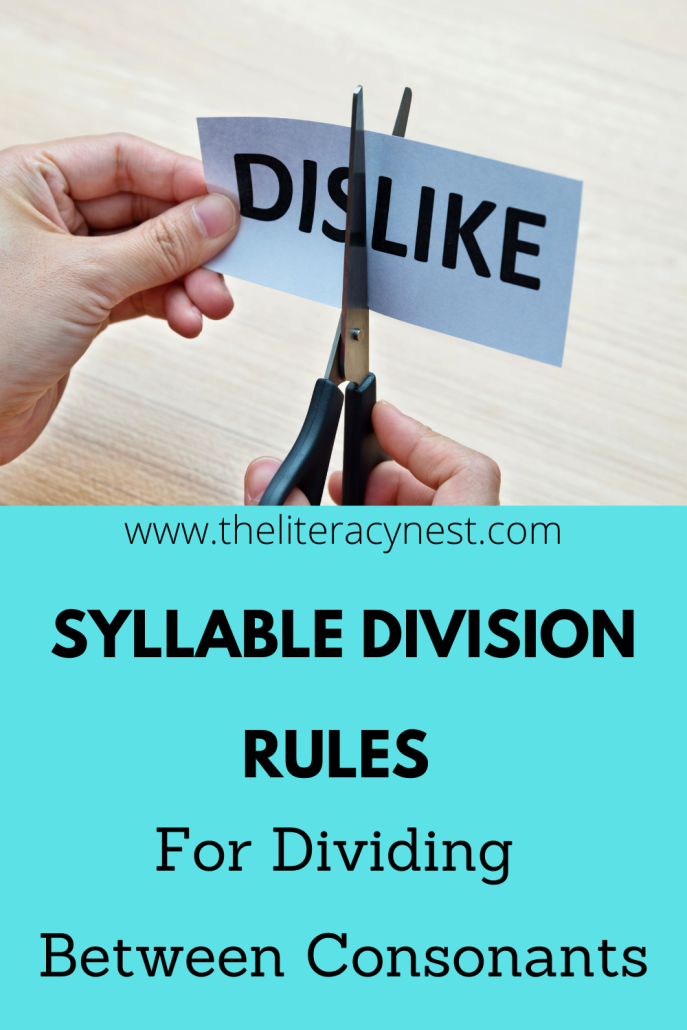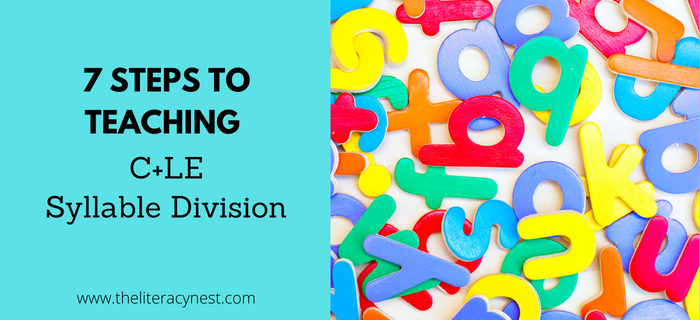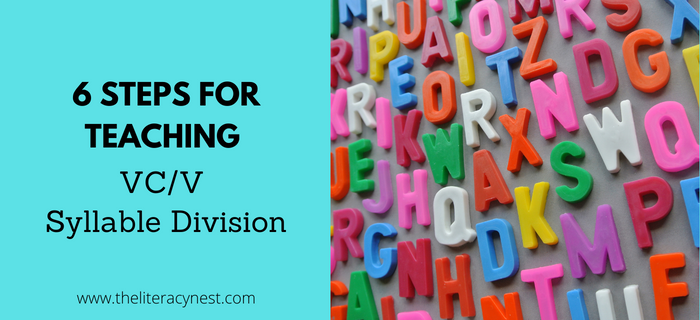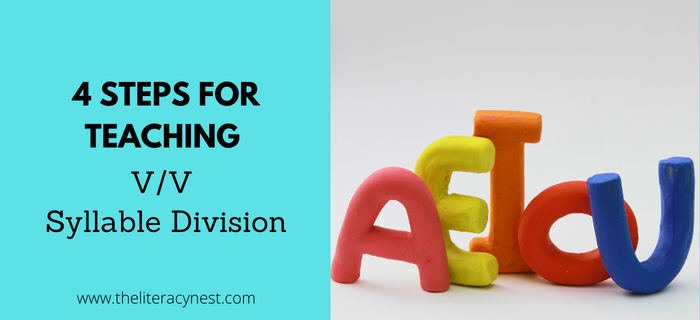Syllable Division Between Consonants
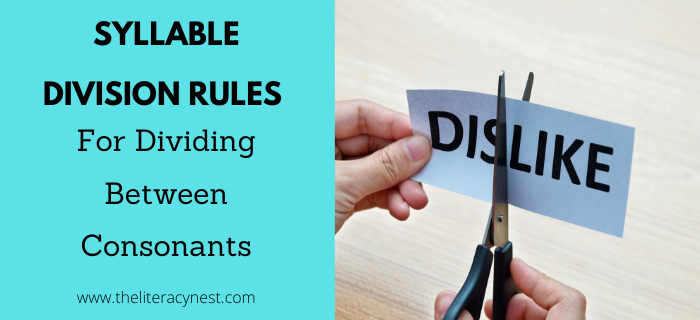
Just as learning syllable types is an ongoing process that continues and builds over time, so too is learning about syllable division. Learning to divide multisyllabic words opens many doors for students and expands the number of words that they can successfully decode. Your Orton-Gillingham students may feel overwhelmed and panic when presented with a long unknown word. Teaching syllable division gives your students the tools to take any multisyllabic word and break it down into bite size single syllable pieces.
When Can I Teach Syllable Division?
Teaching syllable division between consonants is the beginning of this process and can really be taught any time after solidifying short vowel sounds in closed syllables. I typically teach syllable division after introducing closed syllables. Rules for syllable division will build as you introduce vowel-consonant-e and open syllables, Applying their skills to multisyllabic words helps them to quickly see the benefits of their focus on basic skills.
Laying the Groundwork for Syllable Division
Explain to your students that the vowels are the key to a word. The vowels can reveal the syllable type, the number of syllables and the sound that the vowel is going to make. So, whether they are decoding a single syllable word or breaking up a longer word, underlining the vowels is an important first step. It brings their attention to the vowel sound. Every syllable must have a vowel, so the number of vowels can tell us how many syllables are in the word.
Beginning Steps
Dividing syllables between consonants is the most common type of syllable division and is applicable regardless of syllable type or length of word. I begin by teaching students to divide words with 2 consonants between the vowels. I have found the following technique to be very successful for introducing the concept and for scaffolding for a student if they are struggling with dividing a word later.
- Write a word in large letters on a chalk board or white board. If teaching remotely, it is helpful to stretch the word so the spacing between letters is loose on the slide or app you are using.
- Ask student to underline the vowels in the multisyllabic word.
- Ask student to place their left hand on the first vowel and their right hand on the second vowel. It is helpful to adjust your instructions here to the individual child. For children that struggle with oral language, modeling or providing hand over hand support to complete this step may be helpful.
- Ask the student to look in between their fingers and verbalize what they see. Initially, this would be two letters which happen to be consonants.
- Explain to the student that when there are 2 consonants, they are going to divide right between them. Model how to mark syllable divisions with a slash or by scooping syllables.
Hands-on Syllable Division
After learning how to divide syllables in this multisensory way, it is important for students to have the opportunity to practice with many examples until this process becomes increasingly automatic. This can be done in a similar fashion as the teaching process or using Unifix cubes, or cutting word cards. The more difficult your students finds this concept, they more beneficial they will find more exaggerated hands on approaches such as physically breaking apart the words with building blocks or cutting apart the words.
Ultimately, as this process becomes more comfortable, students will be able to divide words visually using this process as a fall back when something is tricky. It is helpful for many students to mark short vowels with a breve and long vowels with a macron. It can also be useful to indicate syllable type. I typically use C to indicate closed, O for open and E for Vowel-consonant-e syllables. If students have difficulty identifying C/C syllable patterns, you may wish to have them code the consonants with a C and Vowels with a V.
Initially when reading and writing multisyllabic words, I recommend reading only words with 2 consonants between the vowels and writing words only with 2 different consonants between the vowels. This enables students to read and write words such as Wisconsin, Atlantic, fantastic, and cupcake.
Continued Practice with More Consonants
After becoming proficient with C/C syllable division, it is valuable to extend syllable division to VC/CCV and VCC/CV syllable division. I typically teach this skill a few weeks later after division between two consonants has become quite confident. VC/CCV and VCC/CV syllable division really lends itself best to being taught together. These forms of syllable division require analysis, decision making, and ultimately trial and error.
- Begin instruction as for C/C syllable division with a large model word on a white board or chalk board.
- Ask students to underline the vowels in the multisyllabic word.
- Ask students to place their left hand on the first vowel and their right hand on the 2nd vowel.
- Ask student to look in between vowels and verbalize what they see. If they do not mention the number of consonants prompt them to count the consonants.
- Since there are 3 consonants, it is impossible to divide the word in the middle. Students should look for a digraph or blend.
- Explain that it is necessary to make a choice. The most common way to divide a word is after the first consonant, but it is important keep digraphs and common blends together. Sometimes, it seems like both options are possible. In this case, students may need to try both options for syllable division in order to find the correct option.
For example, in the word mushroom, the syllables would divide as mush/room. The sh would be kept together as a common digraph. The same is true of bathtub, backpack or pumpkin. Th and ck are common digraphs. Mp is a common blend, but pk is not a common spelling pattern. In a similar fashion bobsled, complex, and conflict will keep the common blends of sl, pl and fl together.
For words with 4 consonants in between the vowels, there are two common possibilities.
- For compound words, the syllables divide between the two words making up the compound word. This is often right in the middle of the 4 consonants as in the words dish/cloth or hand/stand, but may vary as in match/box.
- Another common way that 4 consonants will divide is after the first consonant. This keeps a 3 letter blend together, as in the words con/struct or in/struct.
Please remember…
It is important that students become confident and proficient with syllable division between consonants before expanding to other types of syllable division. After teaching division between 3 and 4 consonants, I typically shift my teaching focus to syllable types such as r-controlled and vowel teams, allowing students extensive practice with this skill.
Great ways to practice include building words by combining syllables, sorting words by how they are divided, locating blends and digraphs, using blocks to divide words or cutting word strips or cards to mark the divisions between syllables. Once syllable division has been introduced, it is helpful to incorporate multisyllabic words into both new and review lists. This is helpful for students to integrate their new learning with old.
Are you looking for resources to teach syllables?
The TPT back to school sale will help you stock up on resources for teaching syllable division. You’ll find my store on sale on 8/2 and 8/3. Save up to 25% off in my store with code BTS22.


Coming soon…
I’ll be adding blog posts to teach other syllable division rules.
